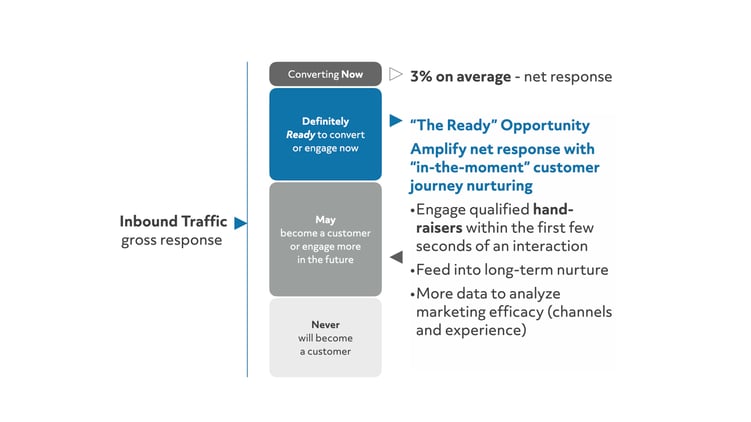Web Experience Optimization
Four Principles of Web Experience Optimization: Winning Over the Ready
Our experience in observing digital behaviors over the past decade and today, continues to show substantial opportunities for yield improvement for marketers and brands. Providing digital consumers and visitors with opportunities for self-identification can help brands uncover and engage with an often ignored persona: The Ready—visitors who represent significantly more than the 1-3% who are converting now.
Here are our four key principles of experience optimization that we have found can produce better results. Consider these as you plan and execute your paid, earned, and content marketing campaigns for sustained growth throughout 2020 and beyond.
● Experiences should be conversational and customer-centric: As mentioned in our relationship-first posts, to create a balanced brand-customer relationship, it’s important to provide your customers with experiences that put them in charge and allow for self-identification and thus increased engagement. This involves changing the overall structure of the content to improve behavior. Consider the following when building experiences:
○ Use customer-centric language (rather than product- or brand-centric).
○ Limit the number of click options per-page.
○ Break up and spread content across sequential pages.
○ Optimize content for speed and momentum, to accelerate the path to conversion.
○ Think about building entire experiences, rather than trying to get the conversion ‘on the first page.’
● Analyze and optimize customer journeys with a visual-first approach:
Viewing screen-based experiences through the eyes of visitors requires laying out the sequence of events that visitors actually see and experience over a matter of seconds or minutes, where most of the drop-off occurs. This entails mapping out thumbnails of each part of the journey, overlaying the statistics—traffic volume, bounce, engagement, and conversion rates. This allows you to visually analyze where loss is occurring and where visitors are engaging, at a holistic experience level.
Of course, it can also help to use page-level analysis tools including heatmaps and others. But the real opportunities for growth lie in what happens across multiple steps or pages. At Blue Green, we decided to create a tool (Blue Green Analytics) to help us do this type of analysis in real-time.
● Ensure continuity across micro-steps in an experience: Whether your desired conversion is to have visitors complete a purchase, fill out a form, download a case study, or submit an email address, it’s important to pay very close attention to continuity (or the lack thereof) across various interactions in the customer journey. For example, keywords and messaging used in an ad should also be incorporated into the web experience. Ideally, each progressive step should provide more and deeper opportunities to move closer to conversion through a continuous stream of relevant ‘call and response’ actions. A deeper discussion on this topic can be found in this article from Search Engine Land, co-authored by Blue Green’s Jeff Eckman and Paul Benson of Synapse SEM.
● Test and Earn—Consider high-contrast, A|B|C testing: Testing and learning in the traditional sense is not practical, as things that are learned can have a short shelf-life—context is always changing. Further, rather than test to learn, why not test to earn? Continuously test entire experiences against a control (i.e. your current or existing experience), and ensure these new experiences vary significantly from the control in terms of design, content, and structure. Keep the control only for as long as it makes sense from a financial standpoint. That is, once the control is underperforming to the degree that by keeping the control in the mix, you are losing money, shut down that control.
A high-contrast, entire experience approach works with lower volumes of traffic—and therefore can produce faster results—than traditional on-page or multivariate testing. For more on statistical significance in A|B testing or multivariate testing, see this Wikipedia article for a primer.
Tell us how you are building, analyzing, and optimizing your digital user experiences. Reach us at feedback@bluegreenbrands.com.
Recent Articles
Agile CMS
Blue Green Named HubSpot Advanced CMS Implementation Certified
As a HubSpot Solutions Partner since 2019, bringing HubSpot CMS to enterprise before there was HubSpot CMS Hub Enterprise, Blue Green is truly honored to have been selected as one of HubSpot’s Advanced CMS Implementation Certified partners.
Read More…
